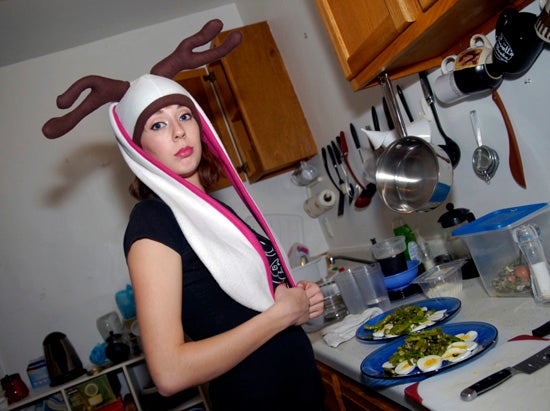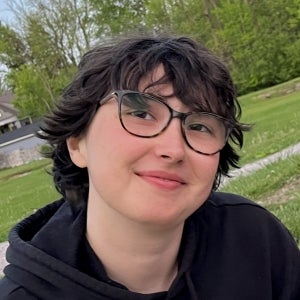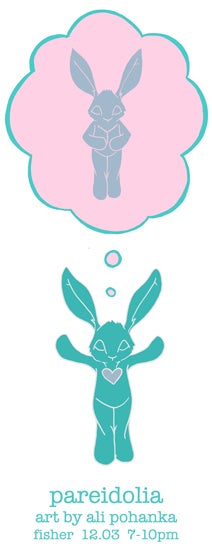Ma'ayan's guide to a senior art show, a near-the-insider's perspective:
A. Know an Ali Pohanka
B. Love her dearly
C. Listen to her hare-brained ideas (pun completely intended, more to come) and brainstorm
D. Talk about colors with her
E. Exert excess creative energy into cooking
F. Help her kick ass at posters, painting, and promotion
G. Take photos, make videos, drink wine, hug the Pohanka family
H. High-five her 100 times (that's 500, for those of you counting at home)
I. Miss her like hell when I realize she's leaving in December (but not going too far, she's doing her final winter term project with my most favorite theater group in the world, the Striking Viking Story Pirates).
My delightful friend Ali, colorful, sparkly, creative Ali, is having her art show, Pareidolia, at the beginning of art show season this year, with her show opening December 3rd in Fisher Gallery.

This is Ali. This hat is very important to her existence and to this show.
For the rest of the year, Fisher Gallery and the new Richard D. Baron '64 Art Gallery in the Ward alumni center will be a rotating showcase of sculpture, silkscreens, photos, paintings, clay, paint, fabric, metal, paper, canvas, paper mache, ceramic, found objects... you name it, you're probably going to see it teased, recreated, and inspired under studio lights while dining on wine and cheese. And as soon as that hustle and bustle is over, the Friday night opening, the Saturday and Sunday open viewings, the entire show disappears by Monday morning, when galleries are reinstalled with the next rotation of student work.
I love art shows. I've seen reimagined suspended forests with fresh dirt underfoot, I've seen large-scale staged narrative photographs, I've seen three-dimensional sculptures of movement depicted in pins and paper, I've seen graphic novels printing on thousands-of-DPI printers next to oil paintings, but I have never been this closely involved with what it takes to put up an art show.
I only recently started thinking about myself as an artist, and not just a capturer of life, which means I only recently started thinking about how and where art is presented. Before the Allen closed for renovations, I was a docent at the museum, leading tours of school children and Kendal residents and showcasing my favorite pieces that the Allen had to offer. The Allen divides up their pieces into rather natural divisions, with rooms and sections of the main gallery with grouped pieces of art (a modern corner, a contemporary gallery, an annex of sculptures, wings of European art and Medieval and Renaissance art). However, sometimes pieces in these designated parts of the museum end up in a different grouping: a new exhibition, either in the Allen or elsewhere.
Now, as a docent, this sometimes would get confusing, remembering that the Monet was always in the northwest corner of the main gallery and then realizing it was in the Landscapes exhibition in the Stern gallery, but it was actually quite amazing. The groupings, the placements, and the juxtapositions of the pieces, even if they moved 100 feet across a room, would have different meaning and relationships and garner a difference emotive or intellectual reaction from the viewer, just by where they were placed.
Wrapping your mind around a gallery space, when you have every single wall, floor, ceiling, doorways, lights at your disposal, is a difficult thing. I don't know how one does it, but I'm attempting to soak up some of Ali's brilliance during the course of this week. Organization is important. Careful thought is important. Placement is important. Once you place, you light. Once you light, you photograph. Once you photograph, you open.
Even before the art hits the ground (or wall or ceiling) running, there's the creation process. During the past semester, Ali would occasionally pop into my house with a selection of paints and paper, where she'd apply color theory and paintbrush to paper in a flurry of twisted pastels and Leporidae would emerge.
In her studio and at home, she made miniature mounted heads (when she brought these over to Brandi's during dinner one night, I thought they were creatively shaped marshmallows), stuffed and paper mache creatures, sketches, paintings, and drawings. Brandi's father sent her a box of antlers and we went on a field trip to Home Depot to find moldable latex. This process was fascinating. I don't know how to create things with my hands. I was in complete awe. Colors! Shapes! Textures! Not edible!
In the week before a show, all the artwork is done. You have to start preparing for the show, and the creation of art is no longer on your mind. Posters are designed and screenprinted and trimmed and campus is papered. Facebook events are made and friends and professors are invited. Family and close friends jet in and drive down. Wine is uncorked, cheese and crackers are arranged.
And then there is an art show. Photos and videos and high fives to come.
Poster design and execution by Ali Pohanka and Dashiell Robb.




